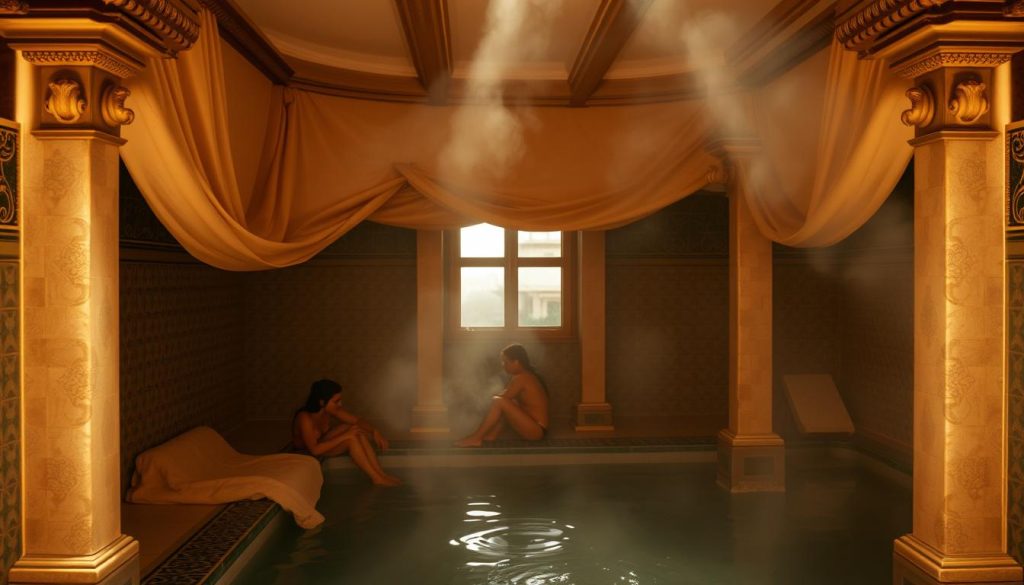Ever wondered what makes a Turkish bath such a memorable part of a trip to Istanbul? You step into a domed, marble room where heat, water, and skilled care guide a clear ritual. The göbek taşı warms you while attendants lead you through a warm-up, kese scrub, and foamy soap cleanse.
The experience blends centuries-old design with modern comforts. Kurna basins let you control hot and cold water with tas bowls, and many venues now add skincare, waxing, or hot stone options. Historic domes sit beside luxury suites and jacuzzis, keeping the core ritual alive.
You’ll find gender-specific hours or separate areas, a quiet respect for modesty, and staff who aim to renew your skin and calm your mind. For travelers who want guidance on where to go and what to expect, visit this helpful guide for more details: Turkish bath guide.
Key Takeaways
- You’ll experience a ritual focused on heat, marble göbek taşı, and water control at kurna basins.
- Expect a clear flow: warm-up, exfoliation with a kese, and a foamy cleanse.
- Modern venues mix historic architecture with extras like jacuzzis and VIP suites.
- Gender-specific times and modest service styles remain common.
- You can extend your visit with skincare, waxing, or oil treatments for deeper relaxation.
Your Ultimate Guide to Relaxation in Istanbul Today
Choosing the right time and service makes your visit smooth and relaxing. Book ahead via official sites or trusted apps, especially during peak seasons. Many venues list packages that combine a kese scrub, bubble wash, massage, and skincare so you can pick what fits your needs.
Compare cleanliness, reviews, and pricing before you commit. Look for clear service descriptions and honest photos. If you want fewer crowds, aim for midday slots—those often mean a calmer day and more one-on-one attention.
- Plan your visit around location and transport to save time and stress.
- Check package details to avoid surprise fees and to match your budget.
- Women can find women-only venues or gender-specific time slots for comfort.
| Factor | What to look for | Why it matters |
|---|---|---|
| Booking | Official site or trusted app | Guarantees your slot during busy periods |
| Packages | Kese, bubble wash, massage, skincare | Transparent inclusions help compare value |
| Best time | Midday for fewer crowds | More calm and personalized attention |
| Women-only | Separate hours or venues | Privacy and comfort |
For a deeper look at top venues and how to book confidently, consult this hamam guide. Use the checklist above and you’ll plan a relaxed, well-timed experience that fits your expectations.
From Ritual to Relaxation: A Brief History of Turkish Baths in Istanbul
Under bright skylights, white marble rooms became hubs where daily life and ritual met. Since the 15th century, these halls served as social and spiritual centers that reflected Ottoman luxury and civic life.
Ottoman origins and social life under the domes
Polished marble, domes, and arcades created an elegant setting for gatherings. You’d find ceremonies, pre-wedding events, and communal cleansing that bound neighborhoods together.
How Roman and Byzantine bathing shaped the hamam
Roman and Byzantine engineering influenced heating systems, layout, and service flow. The hamam adapted those methods and made them a social ritual you can still see today.
Why baths cluster near mosques and marketplaces
Many historic hamams sit close to mosques and bazaars so people could purify before prayer and meet friends during errands. Landmark examples include Cağaloğlu Hamam (1741) and Kılıç Ali Paşa Hamam (16th century), which show this urban logic.
- You’ll trace how ancient bathing evolved into Ottoman-era rituals that shaped daily life.
- Architecture here was practical: domes, skylights, and marble kept heat and sound controlled.
| Aspect | Origin | Why it matters for your visit |
|---|---|---|
| Layout | Roman/Byzantine | Comfortable flow and gradual heating |
| Social role | Ottoman | Community events and privacy options |
| Location | Near mosques/markets | Convenient for cleansing before prayer and errands |
For a broader look at spa history and wellness, see this spa culture and wellness guide.
Inside the Hamam: Architecture, Rooms, and the Marble Heart
The main hall opens as a rounded sanctuary where underfloor channels and a high dome set the thermal tone. You’ll feel even warmth and clear air flow that prepare your body and mind for what follows.
Göbek taşı, kurna basins, and the domed steam room
The göbek taşı is the heated marble platform at the center. You usually rest there for about 15-20 minutes to warm muscles and open pores before any service begins.
Kurna basins line the walls with separate hot and cold taps. You control water temperature and rinse using metal or copper tas bowls for a hands-on rinse.
Hot and cold flow, tas bowls, and steady thermal comfort
A furnace sends hot air through conduits beneath the floor, keeping the circular steam room warm but balanced. Small skylights and acoustic planning calm sound and light, making the whole space feel composed and timeless.
- You warm on the marble to prepare for exfoliation and foam.
- Use the kurna taps and tas to fine-tune rinse comfort.
- Design details—domes, marble, and vents—support a smooth ritual from warm-up to rinse.
What to Wear and Bring: Modesty, Towels, and Essentials
“Simple choices—what you wear and what you bring—shape how relaxed you’ll be during the ritual.”
Simple packing makes your visit smoother. Most people wear undergarments or swimwear wrapped with a lightweight peştamal. This keeps you cool and respects local modesty norms.
Bring waterproof slippers for hygiene and traction. Some venues supply slippers, but your own pair is more sanitary. Pack a kese mitt and a soft sponge if you prefer to use your own tools.
- Carry natural olive oil soap and shampoo to care for skin and hair.
- Choose a plush towel to dry off; a thick towel helps when you move to cooler areas.
- If you are a women, seek women-only hours or sections for privacy and calm.
- Store belongings in lockers or key-access cubicles offered by many venues.
- Check package details so you know which services and items are included before you pack for your visit.
“Bring what makes you comfortable—small items can make a big difference.”
For more tips on choosing the right options and packages, see this helpful guide: best options and experiences.
The Classic Turkish Bath Experience: Step-by-Step
Start your ritual by settling onto the warm central slab; the steady heat loosens muscles and gently opens pores. Rest for about 15-20 minutes so your body and skin prepare for the next phase.
Warming up
Spending those initial minutes on the marble helps circulation and softens dead cells. This quiet pause makes the following scrub more effective.
Kese scrub
The kese mitt is used with firm, repetitive strokes to lift old skin. You may see visible rolls of exfoliated skin—that’s normal and a sign the scrub worked.
Foamy soap and head care
After the scrub, attendants apply a fast, sudsy soap cleanse paired with a gentle, light massage. If you choose, a shampoo head massage adds a soothing finish many guests love.
Rinsing and cooling down
Thorough rinsing with warm then cool water helps close pores and re-center your senses. You’ll then move to a cooler room to rest and sip water or tea.
- You warm on the marble for minutes so your body relaxes.
- The scrub leaves your skin smooth and refreshed.
- A bubbly soap cleanse follows, easing tension across your body.
- Rinsing with cool water finishes the ritual and readies you to unwind.
“You should expect to leave feeling lighter, with softer skin and a calm outlook for the day.”
| Step | What happens | Typical timing | Why it matters |
|---|---|---|---|
| Warming | Rest on heated marble | 15–20 minutes | Opens pores; relaxes muscles |
| Kese scrub | Exfoliation with mitt | 5–10 minutes | Removes dead skin; smooths surface |
| Foamy soap | Quick sudsy cleanse and light rub | 5 minutes | Soothes and cleans; lifts remaining residue |
| Rinse & relax | Warm then cool water; lounge time | 10–15 minutes | Closes pores; restores balance |
For practical tips and booking advice that match this step-by-step experience, check a trusted local guide: professional hamam guide.
Services You Can Book: Scrub, Massage, Skincare, and More
You can build a custom set of treatments that starts with the signature kese scrub and bubble wash. These two elements form the backbone of many hamam packages and set the stage for any extra service you choose.

Signature kese scrub and bubble wash
The kese scrub exfoliates dead skin and brightens your complexion. The follow-up bubble wash soothes and cleanses, leaving your skin soft and renewed.
Light to deep body options
Choose a gentle Swedish-style treatment for circulation, or pick a hot-stone option for deeper tension release. Ask about timing so treatments flow without hurry.
Skincare rituals: oils, clay masks, and honey
Many venues offer natural-oil exfoliation, mineral-rich clay masks, and honey hydration. These add-ons nourish skin and extend the post-visit glow.
Waxing traditions and timing your treatment
Waxing often uses a lemon-sugar method applied with fabric strips. Schedule waxing before any scrub or soap; do not wash the area beforehand so results hold better.
- Tailor services to your needs—start with the classic scrub and bubble wash.
- Pick a body option from soothing Swedish to heat-enhanced hot stone.
- Try skincare add-ons like oil exfoliation, clay masks, or honey hydration.
- Have waxing first to protect treated skin and improve results.
- Review each service duration and inclusions so you can stack treatments comfortably.
- If you are a women, confirm female attendants or women-only hours for privacy.
- Look for bundled packages to maximize results and value.
- Note whether venues follow traditional turkish techniques or modern spa approaches.
“Plan the sequence—wax first, then scrub and soap—to protect your skin and enjoy every service.”
For a focused facial add-on, see this trusted guide to a dedicated treatment: facial treatment experience.
Choosing Your Place: Luxury Spa Hamams vs. Historic Domed Baths
Pick a venue that matches how you like to unwind—quiet marble domes or private suites with modern comforts.
Luxury spa hamams often add jacuzzis, salt rooms, and private VIP suites for a high-end take on the classic ritual. These sites focus on comfort, extra services, and a secluded atmosphere.
Historic domed baths keep original marble, tall skylights, and a spiritual ambiance tied to Ottoman heritage. They offer architecture and acoustics that heighten the sense of place.
What to compare before you book
- Cleanliness and staff approach to service—this shapes your relaxation and safety.
- Service lists and durations—ensure treatments match your recovery or rest goals.
- Price and booking options—book via official sites or trusted apps during busy seasons.
- Location—choose a place near sights or restaurants to streamline your day.
“Weigh ambiance against amenities: both styles can deliver calm, but they deliver it differently.”
| Feature | Luxury Spa Hamams | Historic Domed Baths |
|---|---|---|
| Key draws | Private suites, jacuzzis, salt rooms | Original marble, domes, historic atmosphere |
| Service focus | Expanded services and personalized sequences | Classic rituals and authentic pacing |
| Best for | Privacy, added amenities, modern comfort | Architecture lovers and seekers of tradition |
| Booking tip | Reserve VIP suites early via official apps | Check opening hours and buy tickets ahead on busy days |
Iconic Turkish Baths in Istanbul to Visit
Some hamams draw visitors for their architecture, others for signature packages that end with soothing treatments. Below are three landmarks you can choose based on location, history, and included services.
Hürrem Sultan Hamam
Located steps from Hagia Sophia and the Blue Mosque, this venue blends historic luxury with curated experiences. You can enjoy a calm setting and tailored options that suit a heritage-focused visit.
Kılıç Ali Paşa Hamam
Built 1578–1583 by Mimar Sinan for naval crews, this gem features a soaring dome and a faithful approach to classic bathing. Traditional services are available, with optional add-ons for added comfort.
Cağaloğlu Hamam
Dating to 1741, Cağaloğlu began as a public çifte hamam linked to Sultan Mahmut’s library. Today it offers signature packages such as the Ottoman Luxury Service—hot room rest, rubbing, bubble wash, and an aromatherapy treatment with linden oil followed by refreshments.
- Compare services and add-ons like bubble washes and tailored massage to match your needs.
- Book ahead on official sites to secure preferred times during busy months.
- Check what each bath includes—tea, towels, or skincare—so you know what’s covered.
| Hamam | Era | Highlights |
|---|---|---|
| Hürrem Sultan | Ottoman era | Central location, curated packages |
| Kılıç Ali Paşa | 16th century | Sinan architecture, authentic setting |
| Cağaloğlu | 1741 | Ottoman Luxury Service, aromatherapy |
For booking tips and timing, consult this guide — why a visit here helps you.
Massage Culture in Istanbul: From Traditional Baths to Modern Massage Therapists
Whether you want full thermal cleansing or focused therapeutic work, options are easy to find across the city. Local attendants and clinic staff offer distinct paths so you can match the visit to your goals.
From tellak and natır to licensed therapists
Tellak (male attendants) and natır (female attendants) perform the kese scrub and foamy soap rub at a classic turkish bath. Their work emphasizes heat, exfoliation, and a communal ritual that has endured for centuries.
When to choose a hamam ritual vs. a modern session
Pick the hamam ritual for a thermal cleanse and full-body exfoliation. Opt for a modern massage when you want targeted muscle release using Swedish or hot stone techniques.
- You’ll see tradition and modern practice side by side, from tellak and natır to certified therapists.
- Combine both for deep cleansing followed by focused bodywork.
- Review venue services and ask if historic baths partner with spa teams for blended options.
| Option | Focus | Best for |
|---|---|---|
| Hamam ritual | Heat, scrub, full cleanse | Detox and skin renewal |
| Modern spa | Targeted massage, techniques | Muscle relief and recovery |
| Combined | Both sequence | Complete reset and therapy |
“Trust your goals—detox, relief, or rest—to guide whether you book the ritual, the session, or both.”
Women’s Privacy, Hours, and Comfort
A quiet, midday slot often delivers the calm atmosphere women prefer for a restorative visit. Many hamams offer dedicated days or blocks of hours reserved for women so you can relax with privacy and confidence.

Women-only options and same-sex attendants
Many venues provide women-only facilities or assign female attendants during those hours. Confirm this ahead of time so you know the attendant and layout match your comfort level.
Booking tips for a calm, crowd-free day
Aim for midday bookings if you want fewer people and more attentive service. Policies and schedules vary, so check the official site or call before you go.
“Plan your time around published women-only hours to enjoy privacy and a slower pace.”
- You’ll find women-only options and gender-specific time windows that prioritize privacy and comfort.
- Confirm same-sex attendants and facility layouts so you feel fully at ease during your visit.
- Aim for a midday slot to avoid peak traffic and enjoy a quieter atmosphere.
- Review each bath’s policies online to align your schedule with its women-only hours.
- Ask what your service includes—towels, slippers, or amenities—to simplify planning.
- If traveling with companions, coordinate time windows so everyone enjoys the right setting.
- Keep modesty attire like a peştamal and swimwear ready for an effortless arrival.
| What to check | Why it matters | How to confirm |
|---|---|---|
| Women-only hours | Ensures privacy and comfort | Official website or phone |
| Attendant gender | Matches modesty preferences | Ask when booking |
| Included items | Prevents surprise fees | Read package details |
For a smooth, well-timed experience you can also check a local guide that lists women-friendly venues and schedules: women-friendly hamam options.
How to Book, What It Costs, and Getting There with Ease
Booking your visit is easiest when you use official sites or trusted apps that list real-time availability. Do this early during busy seasons so you secure the best time and package.
Official sites, apps, and seasonal pre-booking
Reserve via an official bath website or a reputable app to see accurate slots. Peak days fill fast, so book weeks ahead if you can.
Cancellation, prepayment, and package inclusions
Read cancellation rules carefully. Some places allow free changes up to 24 hours, while others ask for prepayment.
Check inclusions line by line: scrub, massage, and skincare items vary. Confirm what your payment covers so you avoid surprise fees.
Hotel transfer services and typical pricing
Many providers offer hotel transfer services for an extra fee or include them in premium packages. Typical transfer costs run about €10–€20.
Keep confirmations handy and arrive 10–15 minutes early to settle before your service starts. If you need support in another language, choose venues and apps that offer multilingual help.
“Book early, read inclusions, and plan transit so your day remains relaxed.”
| Action | Why it helps | Typical fee |
|---|---|---|
| Official booking | Best times and accurate info | Free |
| Prepayment | Secures slot; may reduce cancellations | Varies |
| Hotel transfer | Saves transit hassle | €10–€20 |
Pair Your Bath with Sightseeing: Sultanahmet and Beyond
Combine a morning of monuments with a midday restorative pause under a marble dome. Map your route so Hagia Sophia and the Blue Mosque sit within easy walking distance of a classic hamam. This makes travel simple and gives you a calm pause during a busy day.
Baths near Hagia Sophia and the Blue Mosque
Many renowned hamams sit near Sultanahmet’s main sights. You can step from a mosque courtyard into a quiet, domed interior within minutes.
Booking midday helps you dodge peak queues and enjoy a more private time slot for your scrub and rinse.
Post-bath bites: kebab, Turkish delight, and bazaars
After your session, refuel with kebab plates or light mezes at nearby eateries. Visit local bazaars to sample Turkish delight and browse for peştamals, soaps, or small skincare gifts.
- You’ll map a day that links iconic sights with a restorative bath to cut transit time.
- Choose venues around Sultanahmet to move from monuments into warm interiors quickly.
- Eat well after your session—kebab, meze, or sweet treats help you refuel.
- Browse bazaars for memorable souvenirs tied to the visit.
- Plan your time to avoid long attraction lines and secure a quieter hamam window.
“Capture photos before your visit, then slip into full relaxation without rush.”
| Plan element | Why it helps | Practical tip |
|---|---|---|
| Route | Minimizes walking and transit time | Pick a hamam near Sultanahmet landmarks |
| Timing | Reduces crowds and improves service | Book midday for a calmer slot |
| Food | Refuels after warm treatments | Try kebab or meze nearby |
Plan this simple sequence and you’ll enjoy a relaxed day that balances sightseeing and downtime. The result is a smooth, memorable experience you can savor.
Conclusion
End your visit slowly so the final moments hold the most value. After the göbek taşı warm-up, a firm kese scrub, a foamy soap cleanse, and a cooling rinse, pause in the warm room and notice how your body and skin feel. A short head massage or a targeted session with trained therapists can extend that calm.
Plan your time: choose a turkish bath that matches the vibe you want—historic domes or a venue with VIP suites—and book online to confirm what each service includes. Combine scrub then targeted work, add transfers if needed, and pair the experience with light sightseeing or a meal nearby.
You’ll leave with lighter limbs, softer skin, and a clear memory of domes, marble, and gentle water rituals. Make this a ritual you return to on future trips.






